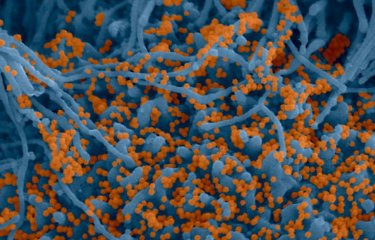-
Vidéo | 2020.02.20
COVID-19 : What we have learnt as of 20 February 2020
COVID-19 : What we have learnt as of 20 February 2020
-
News | 2020.01.22
SARS-CoV-2 : le rôle de l’Institut Pasteur dans la surveillance du virus 2019 n-CoV apparu en Chine (in French)
Dans le cadre de sa mission de surveillance des virus respiratoires sur le territoire français, l’Institut Pasteur mobilise ses équipes, notamment via le centre national de référence (CNR) des virus des infections respiratoires. Son rôle est d’identifier et confirmer les suspicions d’infection respiratoires aiguës liées au nouveau coronavirus apparu à Wuhan, en Chine, en décembre 2019, et dont le...
-
News | 2020.06.18
COVID-19: the latest on the epidemic situation and why caution is still needed
On June 8, the Director-General of the World Health Organization stated that although the COVID-19 epidemic situation is improving in Europe, globally it is worsening, and we must avoid lapsing into complacency. The situation is a complex one. The Institut Pasteur provides a brief summary of the latest developments. What are the current key issues, what monitoring indicators are being used, how...
-
Article | 2020.06.22
Evaluation of clinical presentation and evolution of SARS -CoV-2 coronavirus infection in Senegal
Aim: The overall objective of this study is to understand the main clinical, biological, virologic and immunological characteristics of Covid-19 cases detected in Senegal in order to inform the development and updating of health guidelines for cases management and reduce the potential impact of infection. A retrospective and prospective cohort study of Covid-19 confirmed cases will be...
-
Article | 2020.06.22
Protocol for assessment of potential risk factors for 2019-novel coronavirus (2019-nCoV) infection among health care workers in a health care setting
Aim: Worldwide, the health care workers play an essential role in the clinical management of Covid-19 patients, but in Africa they are also at risk of infection given the level of control measures in hospital wards. This study aims to obtain an early understanding of key epidemiological characteristics in the risk of transmission in healthcare workers in different African countries of the...
-
Article | 2020.06.22
Developing a rapid diagnostic test to detect SARS-CoV2 virus in various environment
Aim: The epidemy of the SARS-CoV-2 virus and its global spread urgently requires efficient means for rapid diagnosis, as well as detection in various environments (aside from clinical laboratories), such as airplanes, schools, potential animal carriers, etc. We have previously devised a colorimetric method to detect specific pathogen sequences using Rolling Circle Amplification (RCA) which...
-
Article | 2020.06.22
Identification and isolation of potent human neutralizing antibodies against SARS-CoV-2
Aim: Neutralizing antibodies (nAbs) hold great potential to prevent and treat SARS-CoV-2 infections. We propose to clone and express monoclonal antibodies (mAbs) from the IgG+ B cells of convalescent patients directed against SARS-CoV2 Spike (S) protein. Their neutralizing capacity will be tested by using pseudovirus particles and virus infection assays. Finally, the B-cell epitopes will be...
-
Article | 2020.06.22
Accelerating the identification & design of SARS-CoV2 antiviral drugs in combination with the “DrugDesign_SARS2” project
Aim: to accelerate the identification & design of SARS-CoV-2 antiviral drugs in combination with the “DrugDesign_SARS2” project. FDA-approved Institut Pasteur Paris platforms, and subsequently, wide libraries of purchasable compounds will be screened in silico to target functions/interactions of RNA_Pol, Spike (virus targets) and ACE2 (host targets) proteins. Prioritization will...
-
Article | 2020.06.22
Urgent Discovery of Drug Candidates That Target Coronavirus SARS-CoV-2
Aim: rapidly provide drug candidates to treat victims of Covid-19. We will do this by applying our cutting-edge technologies and libraries to screen for viable active compounds that kill coronavirus. The strategy will employ phenotype screens (FPDD) that test for coronavirus inhibition using mouse (MHV-59) and human (OC43) virus as models for fast compound screening in cell culture. Direct-...
-
Article | 2020.06.22
Engineering an ACE2 derived polypeptide for label-free, real-time detection on a smartphone device and therapeutic intervention
Aim: The current pandemic of CoV urges for therapeutic options and fast, and cheap diagnosis in alternative to the PCR based technology. We propose characterizing a newly designed polypeptide based on ACE2, which could be the base of detection devices adapted to smartphones and harbors the potential for therapeutic intervention. Focusing on ACE2 overcomes viral mutations, extending the...


